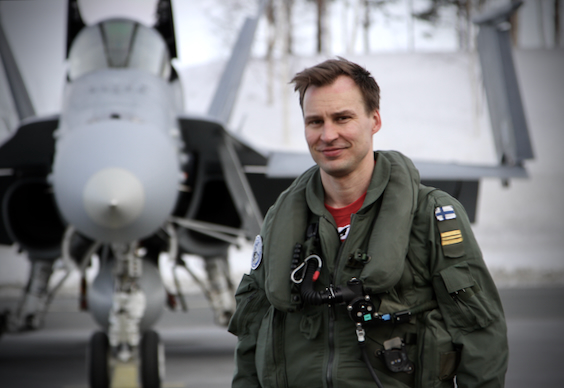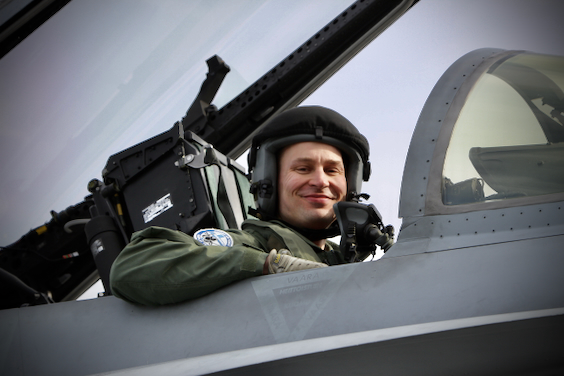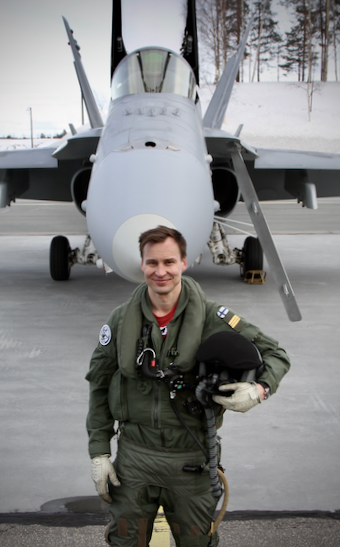Solo Display Flight 2022 Showcases Limits of Hornet
Introducing the Air Force Season 2022 F/A-18 Hornet Display Pilot, Captain Aleksi Ritvos of Karelia Air Command.

The Air Force F/A-18 Hornet multirole fighter solo will be seen this year in several Defence Forces’ events at home and international air shows in Sweden and the Czech Republic. Captain Aleksi Ritvos states it is an honour to have been selected as the solo display pilot. Ritvos rehearses the display routine on top of his usual duties as a Flight Commander at Fighter Flight 31, where flight training and operational activities are his main tasks.
This year the stand-in solo display pilot is Captain Henri Toppari from Lapland Air Command.
How did you become a Hornet pilot in the Air Force?
- A career in military aviation was not an obvious choice for me when I was 19. I like extreme sports, so I decided to use my service period to my benefit after hearing the positive experiences of a mate of mine who had started a year earlier. I began my military service with an open mind in 2006 at Tikkakoski on the pilot reserve officer course, and here I am today. I started flying the Hornet in Pirkkala in 2012 and transferred to Karelia Air Command along with the Defence Forces’ reform in 2014.
You have been flying the Hornet for nearly ten years now - how many flight hours have you accumulated?
- On the Hornet I have altogether about 850 hours. Although I have quite a bit of experience, in this line of work you never really stop learning.
How was the solo display sequence created?
- To prepare for the solo display flight, I have first sat in a simulator for tens of hours. Now and then I tossed a version to the trash and started from scratch again. It’s not until the display routine is completed in the simulator that you are ready to train with a plane. There are three sequences which account for weather changes, for example cloud ceiling. From the previous solo displays, I’ve searched for manoeuvres that have been cool to watch and that I’ve wanted to try myself too. These routines will wow the audience and stay close to them. All the manoeuvres conform to the training programme but in display flying they are brought lower, for example the air combat manoeuvres are normally flown at a much higher altitude.
What is this year’s sequence like?
- It pushes the Hornet to its limits, flying slow and fast, from 200 to all the way over 1000 km per hour. At its lowest, the flying altitude will be approximately 100 metres and at its highest 1500 metres. The display flight will show how quickly the Hornet turns and how extremely capable aircraft it is. The routine includes high angle of attack manoeuvres in which the Hornet’s nose points to a different direction than where the plane is actually heading. The sequence is a bit shorter than the previous ones but it is more dynamic, with no breathers for the plane or the pilot. The flight will last 8 to 9 minutes and it will pull a lot of Gs, so there is no room for mistakes.

Do you have any specific viewing tips for a spectator/photographer?
- Some manoeuvres in the solo display flight are flown using a lot of flares making them more impressive. On the other hand, the high angle of attack manoeuvres also cause the wings to leave a visible trail of smoke. Be sure to get a front row spot.
How does the weather affect the show?
- Cloud ceiling and visibility factor into the performance - how much room you have for flying under the cloud. The better the weather, the higher the altitude you can use. Wind also has an effect on how well the display stays around the pole.
How do you prepare for the actual display flight?
- I train with a simulator in the existing weather conditions. The simulator enables visually the same conditions as the display location. Timewise, this phase takes 15 to 45 minutes. After it, I warm up my entire body, especially the neck and back, so that the physical strain won’t come as a surprise to the muscles. Walking to the plane, I still run through the sequence in my head. That’s my usual routine.
- Display flying is a prominent part of the Air Force and the work of a military pilot. In the background, a large organisation works seamlessly together to make the planes fly. For example, aircraft maintenance plays a big part in keeping the aircraft maintained, airworthy and repaired. You can take off for a mission feeling confident.
Do you ever feel sick when spinning around?
- No, I don’t. In a couple of manoeuvres there’s a lot of negative Gs that try to pull you off the pilot’s seat and lift your stomach to the throat. The first time felt bad but you get used to it. When the manoeuvre is controlled, you are also aware what physical strain can be expected.
What is your normal work day at the Fighter Flight like, what does it entail?
- The squadron personnel’s morning begins with a common brief on the planned missions and tasks for the day. At the same time, we go through the weather conditions and other factors affecting the day’s flight operations. Pilots always have an assigned mission to carry out. Before the flight, the mission is gone through in detail. Then you take off to the sky. After the flight, you review the mission with the help of mission recording and debriefing systems. All of this takes about four hours, and sometimes the whole day.

Sustaining work motivation is a challenge in many fields today, with COVID-19 and the war in Ukraine adding to the burden. A Hornet pilot must be physically and mentally fit - how do you recharge your battery?
- I am able to keep my work self and home self separate. Physical exercise helps in a big way, of course, enabling me to let loose and forget about work.
- In sustaining motivation, the exceptional work atmosphere we have here is vital, and many of us have followed the same education path together for a long time. The atmosphere between the pilots, technicians and other players is second to none. But then again, we all know what the nature of the work is - we are a readiness organisation. We train for emergency conditions every day so that we can do our duty, no matter what.
How would you describe the Air Force as a work place?
- I am happy with my career choice and I find this work very rewarding. In this job, you get a chance to see many interesting places and do work that’s meaningful and worthwhile, which is why we do it. Recent world events prove the significance of Finland’s ability to defend itself and we work proactively to maintain credible national defence. From time to time, I’ve thought of any possible jobs that could beat this one but I haven’t found one yet.
Follow the Air Force on social media
Facebok @ilmavoimat
Twitter @FinnishAirForce
Instagram @ilmavoimat




